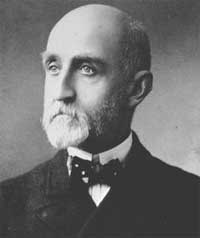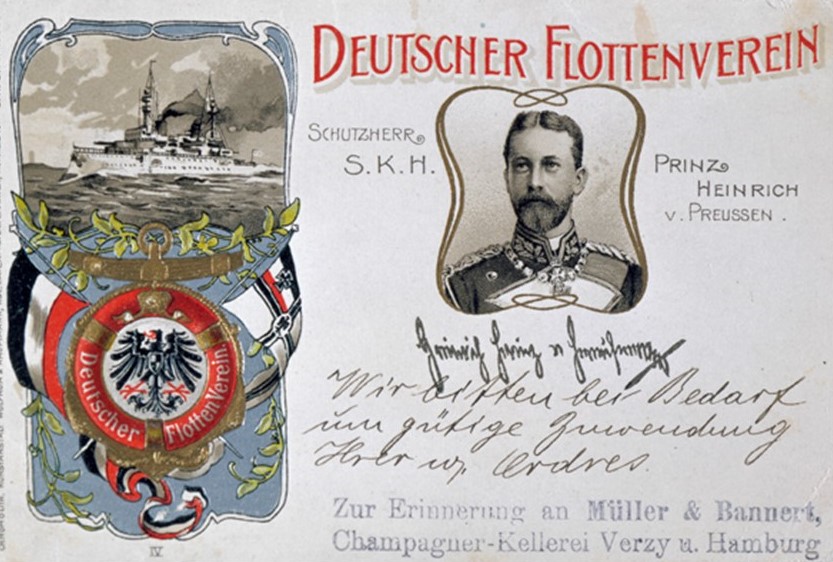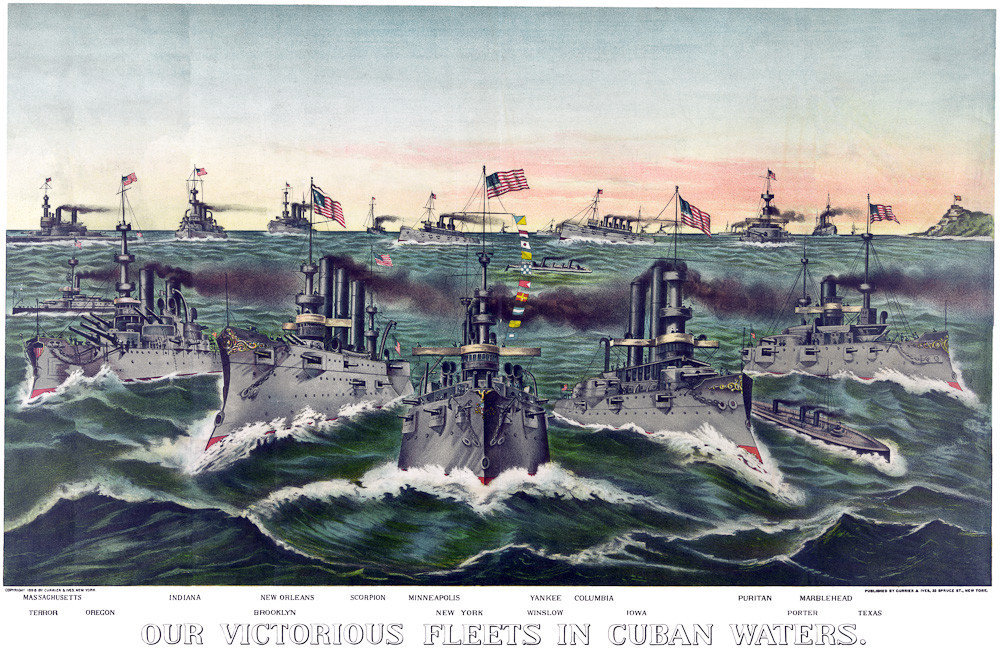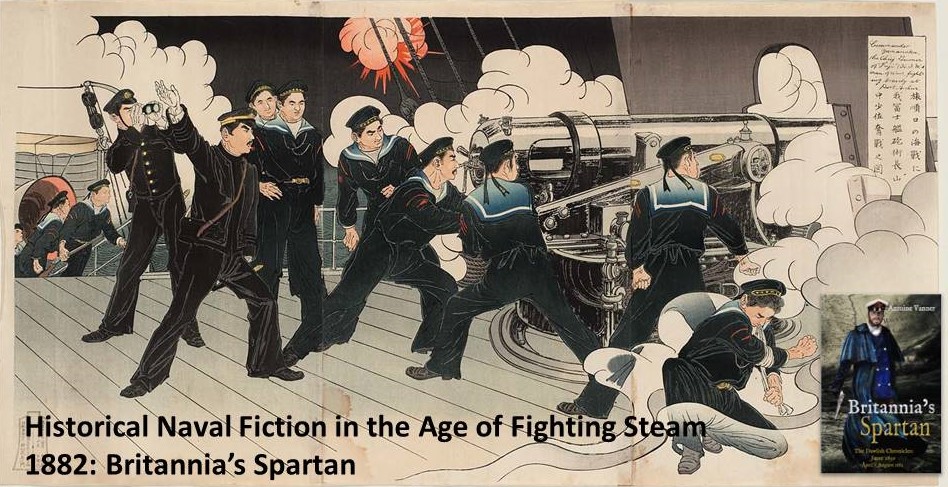The Worship of Naval Power – 1900
 The two decades before the outbreak of the First World War saw naval power being perceived as an essential feature of any self-respecting nation’s power and prestige. Captain, and later Admiral, Alfred Thayer Mahan (1840-1914) of the US Navy was to be the supreme apostle of this view and his early 1890s book “The Influence of Sea Power on History” was to have an immense impact on the policies of emerging powers, not least Germany, the United States and Japan. At the time of the book’s publication all three nations possessed small navies – virtually coast defence forces in the case of Germany and the United States – and Mahan’s insights were influential in convincing leaders that possession of “blue water navies” were essential to national greatness.
The two decades before the outbreak of the First World War saw naval power being perceived as an essential feature of any self-respecting nation’s power and prestige. Captain, and later Admiral, Alfred Thayer Mahan (1840-1914) of the US Navy was to be the supreme apostle of this view and his early 1890s book “The Influence of Sea Power on History” was to have an immense impact on the policies of emerging powers, not least Germany, the United States and Japan. At the time of the book’s publication all three nations possessed small navies – virtually coast defence forces in the case of Germany and the United States – and Mahan’s insights were influential in convincing leaders that possession of “blue water navies” were essential to national greatness.
The first vindication of such policies came in the mid-1890s when Japan, with still-limited forces, scored a smashing victory over China and laid the foundations for a yet more decisive victory over Russia a decade later. In 1898 the US Navy, still small, but modernising and expanding rapidly, annihilated Spanish power in the Americas and in the Philippines and established the United States as a global player. Most significant of all was that Germany’s Kaiser Wilhelm II read the book, decided that every officer in the tiny Imperial German should have a copy and determined to build a fleet that would match that of Britain, thereby setting off a “naval race” in terms of construction, that was a major factor in promoting rivalry between two nations that had not previously seen each other as a threat.

Tppical postcard produced by the German Naval League (Prince Heinrich, a capable naval officer, was the Kaiser’s brother)
Some insight to such public enthusiasm can be found in an American book, “Pike & Cutlass – Hero Tales of Our Navy” by George Gibbs. Appearing in the aftermath of the victorious Spanish-American War, and with the US Navy launched on a massive expansion programme, this publication not only recounts episodes from earlier conflicts but includes a chapter entitled “The Passing of the Old Navy”, which is largely a paean to the modern ships and organisation that was replacing it. One statement is especially notable:
“And yet the poetry has not gone out of it all. The poetry of the sailing-frigate was lyric. That of the steel battle-ship is Homeric…”
The writer goes on to state that:
“Nothing save a war of the elements has the power of a battle-ship in action. Ten thousand tons of steel—a mighty fortress churning speedily through the water – fills the spirit with wonder at the works of man and makes any engine for his destruction a possibility. Away down below the water-line a score or more of furnaces, white-heated, roar furiously under the forced draught, and the monster engines move their ponderous arms majestically, and in rhythm and harmony mask their awful strength. Before the furnace-doors, blackened, half-naked stokers move, silhouetted against the crimson glare, like grim phantoms of the Shades. The iron uprights and tools are hot to their touch, the purple gases hiss and sputter in their very faces, yet still they toil on, gasping for breath, their tongues cleaving to their mouths, and their wet bodies steaming in the heat of it.”

American pride in the US Navy was widespread in the aftermath of victory in the Spanish American War
As the writer continues, it is notable that he assumes a modern naval officer would still be able to handle a vessel under sail:
“The deck above gives no sign of the struggle below. Where, in the old days, the sonorous trumpet rang out and the spar-deck was alive with the watch who hurried to the pin-rail at the frequent call, now all is quiet. Here and there bright work is polished, or a lookout passes a cheery call, but nothing save the man at the wheel and the officer of the watch shows the actual working of the ship.
Seamanship, in the sense of sail-handling, is a thing of the past. Though there is no officer in the navy who could not in an emergency handle a square-rigger with the science of an old sea-captain, the man on the bridge has now come to be first a tactician and after that a master of steam and electricity.”
The modern captain is seen as a heroic, almost mythical, figure:
“In the sea-battles of 1812 the captain was here, there, and everywhere in the thickest of the fight, inspiring by his personal magnetism the men at the guns. He was the soul of his ship. To-day the sea-battle is a one-man battle. The captain is still the heart and soul of the ship, but his ends are accomplished in a less personal way. His men need not see him. By the touch of a finger he can perform every action necessary to carry his ship to victory. He can see everything, do everything, and make his presence everywhere felt by the mere operation of a set of electrical instruments in front of him.
The intricacies of his position are, in a way, increased. He may lose a boiler, split a crank, or break an electrical connection, but the beautiful subtleties of old-fashioned seamanship have no place whatever on the modern war-ship. Let it not be understood that the handling of the great ocean fortress of to-day may be mastered by any save a craftsman of the art…”

Japan’s pride in its navy’s victory over Russia was commemorated in prints of high artistic merit
The writer of the book quoted here was American, but one suspects that the same words could have been written by an Englishman, a German or a Japanese of the same era and supported by large numbers of their leaders and fellow citizens. In the next fourteen years warships would grow ever larger and ever more more complex, new technologies such as turbines, submarines, wireless, aircraft and oil-firing would make their appearance and popular support would be forthcoming for massively increased naval budgets and fleet sizes. The naval races, particularly that between Britain and Germany did not alone lead to Armageddon arrived, but they would be contributory factors.
And when it did, the was little poetry in it …
Britannia’s Spartan
Fourth volume of The Dawlish Chronicles series and can be read as a stand-alone
 1882 and Captain Nicholas Dawlish RN has just taken command of the Royal Navy’s newest cruiser, HMS Leonidas. Her voyage to the Far East is to be a peaceful venture, a test of this innovative vessel’s engines and boilers.
1882 and Captain Nicholas Dawlish RN has just taken command of the Royal Navy’s newest cruiser, HMS Leonidas. Her voyage to the Far East is to be a peaceful venture, a test of this innovative vessel’s engines and boilers.
Dawlish has no forewarning of the nightmare of riot, treachery, massacre and battle he and his crew will encounter.
A new balance of power is emerging in the Far East. Imperial China, weak and corrupt, is challenged by a rapidly modernising Japan, while Russia threatens from the north. They all need to control Korea, a kingdom frozen in time and reluctant to emerge from centuries of isolation.
Dawlish finds himself a critical player in a complex political powder keg. He must take account of a weak Korean king and his shrewd queen, of murderous palace intrigue, of a powerbroker who seems more American than Chinese and a Japanese naval captain whom he will come to despise and admire in equal measure. And he will have no one to turn to for guidance…
Britannia’s Spartan sees Dawlish drawn into desperate battles on sea and land. Daring and initiative have already brought him rapid advancement and he hungers for more. But is he at last out of his depth?
Click here, or on the cover image above, to read the opening chapters free
Click below for more details of hard copy and Kindle editions:
For Britain
For United States, Canada and elsewhere
Click here to download two free Dawlish Chronicles Short Stories
Registering for the Dawlish Chronicles mailing list by clicking above will keep you updated on new books and facilitates e-mail contact between Antoine Vanner and his readers for discussion of issues arising.
Suggestions and constructive comment are always welcome and all emails are replied to. Free short stories, available only to those on the list, will also be made available at intervals.

